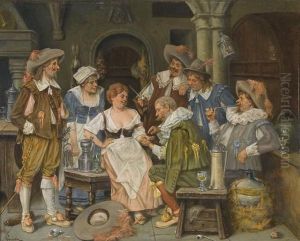Gabriel Christophe Guerin Paintings
Gabriel Christophe Guérin was a French painter and draughtsman born on March 8, 1783, in Paris, France. While not as widely known as some of his contemporaries, Guérin was an accomplished artist of the early nineteenth century, whose work reflected the artistic transitions of his time.
Guérin's artistic journey began under the tutelage of his father, who was also a painter. He later studied at the École des Beaux-Arts in Paris, which was the premier art institution in France. There, he was influenced by the neoclassical style, which was predominant at the time, and that can be seen in his early works. Neoclassicism, with its emphasis on clear lines, classical subject matter, and structured compositions, was a reaction against the ornate Rococo style and was inspired by the art of ancient Greece and Rome.
During his career, Guérin exhibited his works at the prestigious Paris Salon, the official art exhibition of the Académie des Beaux-Arts in Paris. The Salon was the most important art event in the Western world at the time and provided artists with the opportunity to display their work to a wide audience, including potential patrons. Guérin’s participation in these exhibitions helped to establish his reputation as a skilled painter.
Despite his skill and training, Gabriel Christophe Guérin remains a relatively obscure figure in art history, often overshadowed by his more famous contemporaries such as Jacques-Louis David and later, Eugène Delacroix. Guérin's works typically included religious themes, portraits, and mythological subjects, which were common genres of the period.
Guérin's death came in 1836, at the age of 53. Although he did not leave behind a legacy as prominent as some of his peers, his works are still appreciated by art historians and collectors for their representation of early nineteenth-century French art. They contribute to our understanding of the period's aesthetics and the artist's pursuit of expressing human values and narratives through visual arts.
